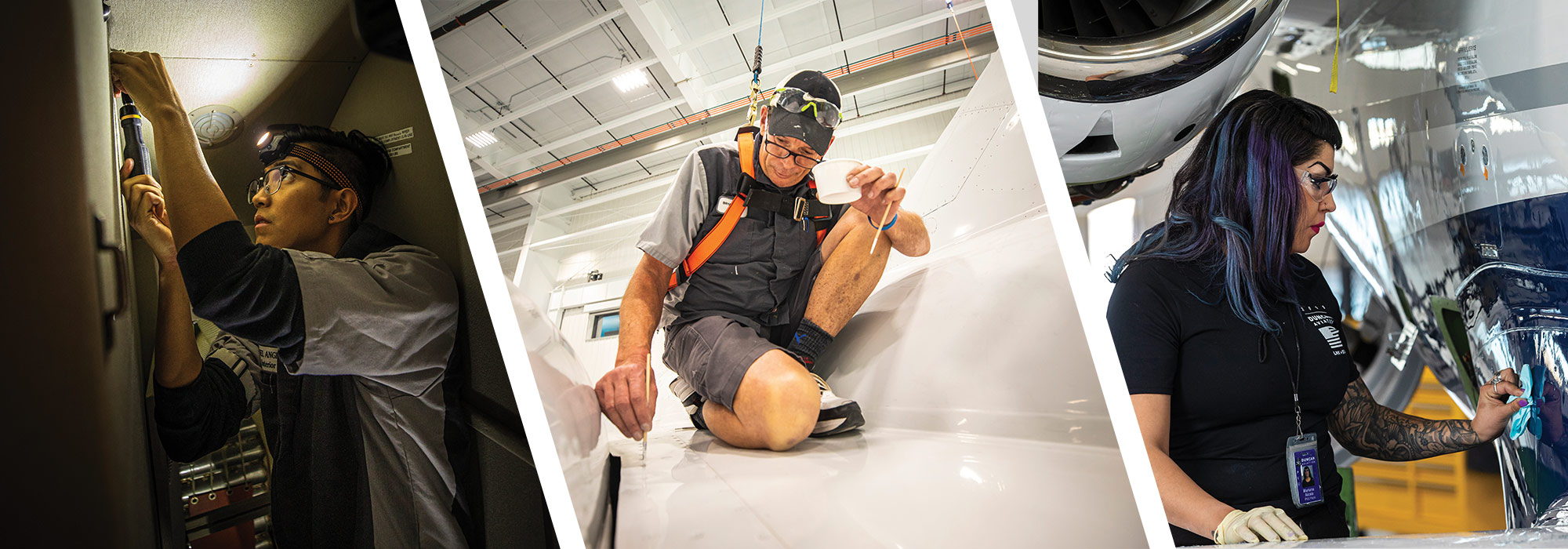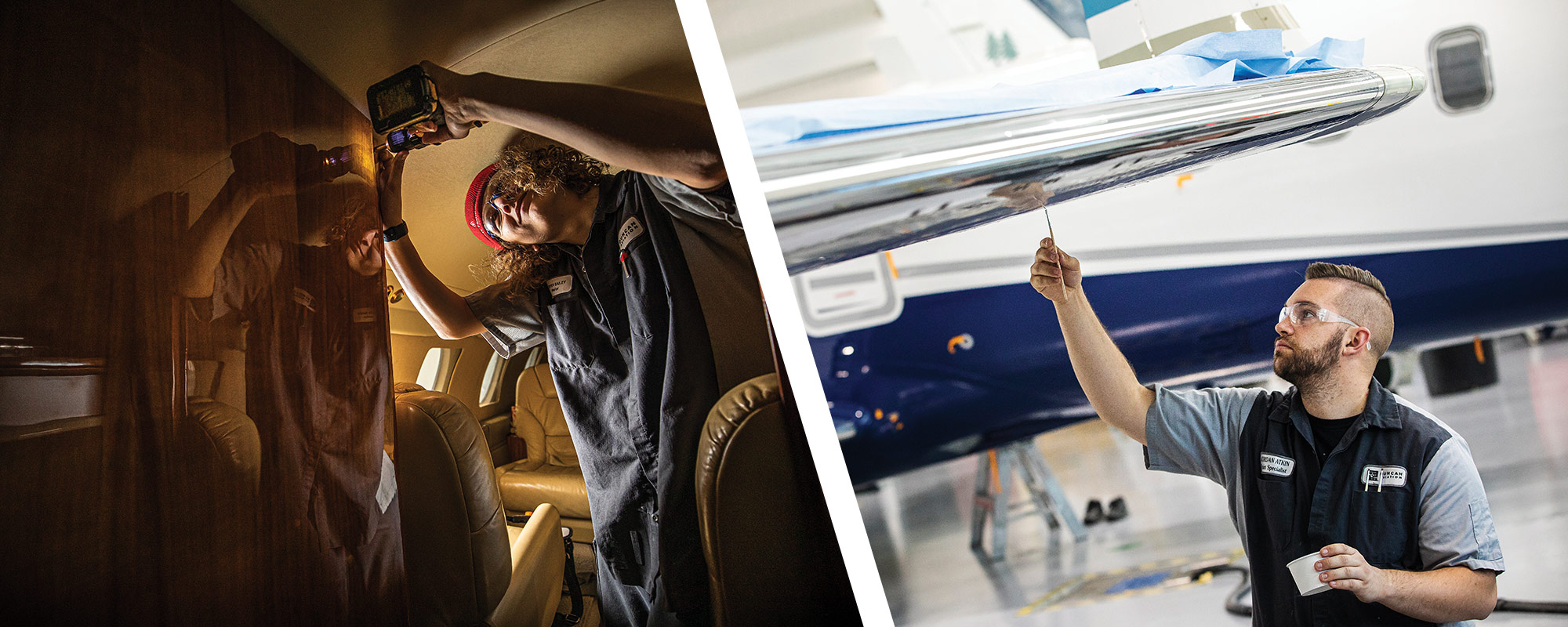
UVU students transfer technical skills to aircraft industry
By Barbara Christiansen | Photography by August Miller
They anticipated they would be fixing dents or replacing bumpers on cars, but some Utah Valley University students and graduates have found themselves applying custom paint jobs to corporate jets valued up to $60 million.
And they have obtained good jobs in a growing industry.
An increasing number of UVU students — from fields including collision repair, automotive technology, and graphic design — have found their place at Duncan Aviation at the Provo Municipal Airport. Duncan is an aircraft service provider, with more than 20 locations nationwide. In Provo, the company recently expanded its facility, including a 275,000-square-foot building for maintenance and modifications, and a new state-of-the-art paint facility.
“Three or four years ago, Duncan invited us to come over and take a tour of their facilities,” says Don Wilson, chair of UVU’s Transportation Technologies Department. “They were going to need technicians, in any possible field that we could train. We do training in areas of refinishing. The types of processes you go through to refinish a vehicle are the same as to refinish an airplane.”
And the similarities are many. Although there are some differences, the basic principles are the same, and students can be quickly trained to add those skills in a field the community and workforce need.
“Paint is paint and electricity is electricity,” Wilson says. “We are not an airframe and power plant program. That particular program has to be FAA- (Federal Aviation Administration) certified. If you are trained in a specific area, they can use those specialties.”
Cayden Bailey is a UVU student who is also working at Duncan Aviation. He has been in the collision repair program and says the skills he has learned have helped him.
“I love it,” he says. “I get to learn new skills every day and apply what I have taken from the collision repair program. I can be that much further ahead of newcomers into Duncan because I have that collision repair background.”
Jake Brewer, the manager of the paint facility at Duncan Aviation in Provo, agrees that the basics are the same.
“They come in with the same basic concept,” he says. “To prep aluminum, we can easily train them on those things based on the experience they got at UVU. It is extremely helpful in training them to do what we do here.”
“The skill set of the UVU students who come out of the automotive program is very applicable to what we do here. I recuit heavily from UVU.”
“We look at experience. It definitely helps,” he adds. “It is a huge plus when we look at it as far as hiring. They definitely have more of an advantage getting a position here.”
Adam Beach, Duncan’s paint and interior sales representative in Provo, says, “The skill set of the UVU students who come out of the automotive program is very applicable to what we do here. I recruit heavily from UVU.”
Despite being prepared to do the work, the students who transfer their skills to the world of aviation have some unexpected adjustments to make.
Pictured from left: Josel Angeles, Bryan Henson, Mariana Alcala

Utah Valley University alumni, many from the collision repair program,
have transferred their skills to employment in the aircraft industry.
“Not really knowing about the corporate jet industry, a lot of them get shell-shocked,” Brewer says. “It is definitely a way larger scale — the amount of materials, and the size of the facility to start with. A large aircraft can cost between $10 million and $60 million.”
And a paint job can be a quarter of $1 million on each airplane, says Jeff Holm, a professional in residence in UVU’s Transportation Technologies Department.
Another big difference is the type of customers they serve.
“I have been working on celebrities’ planes — actors and sports figures,” Bailey says. “It was kind of astonishing to have this celebrity, who I look up to, look up to me for my skill. It was a crazy experience. It was never how I expected anything to go.”
Bailey is attending UVU full time and working full time. The salary is almost double what he had been earning previously, and he says he never had imagined that would happen to him at this stage of his life. The 20-year-old student just purchased a house.
Jordan Atkin graduated from UVU’s collision repair program and has worked at Duncan for seven months. He is in the spot repair department, repainting and blending to fix damage from incidents, including bird strikes.
“I feel UVU’s program has so many options for what it can teach you,” he says. “Not every time when you get a job are you going to be using every single skill. It gave me good insight into what I would love doing. Coming over to aviation, I am still able to apply the same knowledge. It has given me more options with my life.”
Josel Angeles is a UVU graduate in art and design, now working at Duncan. He is an interior specialist, which can include upholstery, seat coverings, carpet, and paint.
“It is basically my dream job,” he says. “It was basically life-changing. It took me seven years to graduate. A counselor gave me a chance to start doing cars. After I graduated, I began fixing airplanes instead of cars. If you don’t know what you are doing, college is pretty hard. UVU has so many programs. Give yourself a break and do some fun classes. Eventually, it will help you.”
“It is basically my dream job...it was basically life-changing.”
With the many applications of skills that students learn, the department has changed its name to better reflect its possibilities.
“We changed our name to Transportation Technologies,” Wilson says. “Our students can reach across several different fields of specialty and be valued employees from rail to aviation.”
They can work with paint, interiors, upholstery, electronics, cabinetry, and use mechanical, electronics, and critical-thinking skills. Some require additional training or certification. With the transferrable skills, the students can work in numerous fields. The field is also growing and the need for new employees is expected to continue to increase.
“The industry is severely hurting for employees,” Beach says.
Bailey says he was enthusiastic about it for himself and others.
“I would recommend the program to anyone who wants to get their hands moving,” Bailey says. “If you are willing to work and want to learn and better your mechanical aspects, I would definitely recommend it. You should take advantage of the opportunities you have. You never know what might present itself.”◼
Pictured from left: Cayden Bailey, Jordan Atkin
